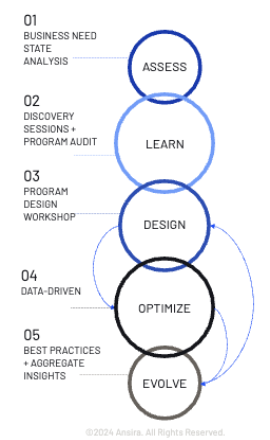What is Channel Marketing?
Channel marketing is when partners like agents, resellers, distributors, or franchisee owners, align with an enterprise company to market or sell the goods and services of the enterprise brand on their behalf. This indirect sales motion is a long-standing marketing and sales model to drive revenue and growth for enterprise companies. Channel marketing is the activation of reaching a target audience through a distributed sales network or partner ecosystem. Synonyms include partner marketing, through channel marketing enablement, channel partner marketing, ecosystem enablement, strategic partnership marketing, joint marketing etc.
Over the last few years, channel marketing has undergone significant change. Traditional partner models, based on transactions or tiered revenue generation have expanded to include non-transacting partners like influencers, advocates, and communities. Some examples of partner types based on Ansira’s enterprise client portfolio include:
- Agent: Professional in financial services or insurance who represent one or more entities and advise and sell policies or investment portfolios to individuals or businesses.
- Automotive Dealer: A business authorized to sell new and/or used vehicles to consumers on behalf of the enterprise OEM.
- Reseller/Distributor: An entity that purchases goods in bulk and resells them to retailers or end consumers/customers. They may also provide customization or installation services depending on the industry.
- Franchisee: An individual or group entity that purchases the rights to operate a business using the branding, products, and services of a franchisor.
- Advocate: A supporter or promoter of a product or service, without engaging in direct sales transactions.
Each type of partner plays a critical role in reaching and servicing customers within their respective industries. To learn a bit more about non-transacting partners, read Leveraging Segmentation for a Transformative Partner Experience.
The Benefits of Channel Marketing for Your Business
To create successful partner marketing relationships, the emphasis should be on mutual profitability. The traditional measure of success, solely based on the amount of product sold, is no longer sufficient. Instead, both parties should work collaboratively to identify opportunities that benefit each other’s bottom line. This requires a shift in perspective from transactional co-op and market development funds (MDF) to include an additional focus on value creation and shared success through a modern mix of traditional program funds, incentives, and rewards. By fostering a mutually profitable environment, organizations can establish long-lasting partner marketing ecosystems that drive sustainable growth.
Channel partners are expressing high confidence in their ability to drive revenue growth and profit in 2024 – for their businesses and those they sell on behalf of. According to a Canalys poll among a sample of 200+ of Candefero’s partner community, two-thirds of them consider themselves to be in growth mode, with one-third expecting to grow by double digits and be more profitable this year. This level of confidence is reminiscent of the periods following major economic downturns in 2001 and 2008 – which is good news for channel partners looking for recovery later in the year and into 2025.
Key benefits of supporting indirect sales via partner marketing include:
- An augmented source of company revenue in addition to direct sales.
- The ability to leverage partners’ market reach and expertise to drive brand awareness and boost sales.
- Opportunistic co-development or intellectual property creation that would not have otherwise come from within your organization.
Challenges You May Face in Channel Marketing
When the enterprise markets to, through, and with partners you drive competitive advantage for your business, but the process of establishing a partner marketing program and engaging channel partners does not happen overnight. Many organizations still operate their programs manually with spreadsheets. There are challenges no matter the size or global scale of your partner ecosystem. To learn more about must have technology to enable your channel marketing to thrive, check out this article on ten must have partner marketing technology capabilities.
As an ecosystem of partners is established and funds programs designed to support marketing activation across media and engagement channels, consider how you can proactively prepare and work to overcome some of the following common challenges inside your enterprise organization:
- Gaining and maintaining executive alignment and support from across the C-suite.
- Establishing effective communication and collaboration with partners.
- Navigating a diverse set of partner priorities, capabilities, and target markets.
- Maintaining brand equity and compliance in co-sell motions across digital marketing channels and traditional channels to protect the enterprise.
- Managing channel conflict and ensuring a fair and equitable partner program(s) no matter the size of your partner marketing network.
Once your enterprise has committed to indirect sales as a driver of growth, it’s time to start thinking about the future and the long-term state of your partnerships. Karlyn Bentley, SVP of Client Partnership at Ansira, said it best in the 2024 State of Partnership Leaders report published by Partnership Leaders –
“When you envision and plan what your partnership program will look like in the next few years and even the next decade, it’s imperative for companies to ensure they have a platform and infrastructure in place that can support their incentives.
From there, you can begin to build a more complex program design by adding a service and support model that surrounds that. It’s all about meeting partners where they’re at and where they want to be met. As you expand globally, there’s a lot of opportunity for companies to offer services like local language support or global payment processing that appeals to your partners while also alleviating the workload on your team. At Ansira, we’ve seen our clients save anywhere from 40-60% of their time just by implementing a global payment processing system.
Partners, especially larger ones, expect efficient and streamlined processes from their vendors. To remain competitive, companies should be thinking about how they can implement these types of services into their program sooner rather than later.”
How to Develop an Effective Channel Marketing Strategy
Understanding the way that partners go to market is imperative – seems obvious but it’s so very important to know when designing your partner program and channel partnership construct.
Different partner types have different needs. Different routes to market, or the introduction of new routes to market, means partners are motivated differently. The question then is this, “how do you make it easier for channel partners to do business with you?”
The answer, you must as a channel organization operating inside your enterprise, wake up every day thinking about your partners. They are people too and should be treated as such.
Creating a results-oriented channel marketing strategy requires the following:
- Defining clear objectives and goals – is the goal of your partner marketing to increase sales, expand into new markets or regions, or develop new offerings and solutions for joint customers? You might say it’s all those things and more but pick a primary objective and then over time you can expand your goals with partners as your ecosystem becomes more established.
- Partner identification, selection, and management – which channel partners are aligned with your business objectives and goals and how will you enable them to be successful through program onboarding and management? Keep in mind that innovation often comes from unexpected places today. It’s key to factor partner identification on transacting and non-transacting inputs that drive your overall growth.
- Training and enablement – how will you structure program communication, feedback, joint strategic planning, and certification? This phase cannot be overlooked. It is your job to create a partner experience that will drive engagement and adoption of your program(s).
- Co-sell – how will you help partners reach their target audience and enable their marketing campaigns to drive awareness and sell more of your product or service? The marketing landscape today is fragmented and the buyer journey for both B2C and B2B goods and services is vastly different that it was just a few years ago. In designing your co-sell marketing activities, understanding how to best reach your end customer is key.
- Data Optimization – how will you manage, measure, and report on partner value at scale? This stage is ongoing and feeds program evolution and additional partner segmentation over time.
Developing a channel marketing strategy starts with a good framework. At Ansira, we use the process outlined below when working with new clients or helping clients who are ready to evolve and scale their partner marketing programs.

Whether your channel partners include dealers, resellers/distributors, franchisees, or agents, we’re here to help improve the customer experience and increase efficiencies between you and your partners. Want to improve your channel marketing strategy and partner experience? Let’s start a conversation. Contact us to learn more about channel partners and partner marketing to drive brand awareness, reach target markets more effectively, and sell more of your goods and services.

